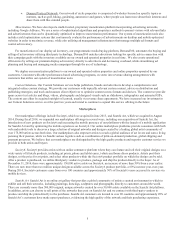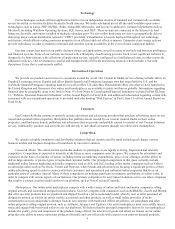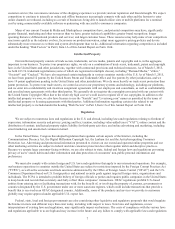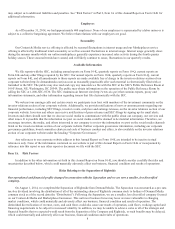Enom 2014 Annual Report Download - page 18
Download and view the complete annual report
Please find page 18 of the 2014 Enom annual report below. You can navigate through the pages in the report by either clicking on the pages listed below, or by using the keyword search tool below to find specific information within the annual report.15
Mobile devices, such as smartphones and tablets, are increasingly being used to access the Internet and our online media offerings
may not be as effective when accessed through these devices. Additionally, mobile advertising yields are lower on average than
those for desktop and laptop computers, which could negatively impact our business, financial condition and results of operation.
Historically, most online media consumption has occurred on a desktop or laptop computer. However, the number of people
who access the Internet through mobile devices such as smartphones and tablets has increased substantially in recent years. If we
cannot effectively distribute our content, products and services on these devices, we could experience a decline in visits and traffic and
a corresponding decline in revenue. It is also more difficult to display advertisements on mobile devices without disrupting the
consumer experience. We may make changes to the layouts and formats of our mobile web optimized sites in order to improve the
user experience or comply with the requirements of our advertising partners, which could negatively impact our monetization efforts
on mobile devices. In addition, mobile advertising yields on average are currently lower than those for desktop and laptop computers,
in part due to the limitations involved in using cookies on mobile devices to track and optimize mobile advertising and the reduced
screen space available to render ads to consumers. The continued increase in mobile consumption of our content, which is now
contributing significantly higher visit growth as compared to visit growth from desktop or laptop computers, has resulted in a
reduction in our Content & Media revenue per one thousand visits, or RPVs. As a result of these factors, the increasing use of mobile
devices to access our content could negatively impact our business, financial condition and results of operations.
If the mobile solutions available to buyers and sellers using our online marketplaces are not effective, the growth prospects of our
marketplace platforms could decline and our business could be adversely affected.
Consumers are increasingly conducting online shopping on mobile devices and tablets instead of desktop computers. Although
we are currently focused on improving the mobile experience for both buyers and sellers using our online marketplaces, the smaller
screen size and reduced functionality associated with some mobile device interfaces may make the use of our marketplace platforms
more difficult or less appealing to our members, and visits to our marketplaces on mobile devices may not convert into purchases as
often as visits made through desktop computers. Society6 and Saatchi Art sellers are also increasingly using mobile devices to operate
and monitor their businesses on our platforms and if we are not able to deliver a rewarding experience to sellers using mobile devices,
our marketplace businesses may suffer. Additionally, developing and supporting apps for our online marketplaces may require
substantial time and resources, particularly as new mobile devices and mobile platforms are released, and we may encounter problems
with our apps or mobile sites after development and launch. If our members encounter difficulty accessing or using our marketplace
platforms on their mobile devices, or if our members choose not to use our marketplace platforms on their mobile devices, our growth
prospects and our business may be adversely affected.
If we do not continue to innovate and provide products and services that are useful to our customers, we may not remain
competitive, and our revenue and operating results could suffer.
Our success depends on our ability to innovate and provide products and services useful to or sought out by our customers. We
must continue to invest significant resources in product development in order to maintain and enhance our existing products and
services and introduce new products and services that deliver a sufficient return on investment and that our customers can easily and
effectively use. If we are unable to provide quality products and services, we may lose visitors, advertisers and customers, and our
revenue and operating results would suffer. Our operating results would also suffer if our innovations are not responsive to the needs
of our customers and our advertisers, are not appropriately timed with market opportunities or are not effectively brought to market.
Historically, the success of our Content & Media service offering has been closely tied to the success of eHow. If eHow’s
performance falters, it could have a material adverse effect on our business, financial condition and results of operations.
For the years ended December 31, 2014, 2013 and 2012, after giving effect to the Separation, we generated approximately 43%,
56% and 57%, respectively, of our revenue from eHow. eHow depends primarily on various Internet search engines to direct traffic to
the site and we have historically had difficulty driving increased amounts of traffic to eHow outside of our SEO efforts. For the year
ended December 31, 2014, we estimate that approximately 81% of eHow’s traffic came from search engines, with nearly all of
eHow’s search engine traffic coming from Google, Yahoo! and Bing. The success of eHow could be adversely impacted by a number
of factors, including further changes in search engine algorithms or other methodologies similar to those previously implemented by
Google, Bing and Yahoo! that negatively impact the volume of referral traffic, some of which negatively impacted search referral
traffic to eHow and caused a reduction in visits to eHow; overall declines in cost-per-click rates seen throughout the industry; our
failure to properly manage SEO efforts for eHow; our failure to prevent internal technical issues that disrupt traffic to eHow; or
reduced reliance by Internet users on search engines to locate relevant content. Additionally, as we continue to evaluate and improve
the user experience on eHow, we may make changes, such as refining the content library, reducing the number of advertising units and
changing the format of advertising units, that are designed to improve the consumer experience on eHow, but which could negatively
impact revenue. We have also already produced a significant amount of content that is housed on eHow and it has become difficult for
us to continue to identify topics and produce content with the same level of broad consumer appeal as the content we have produced
























